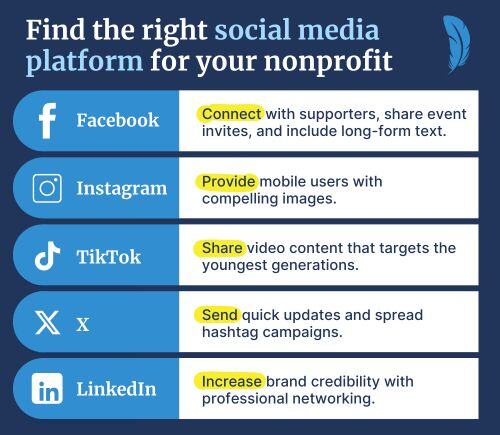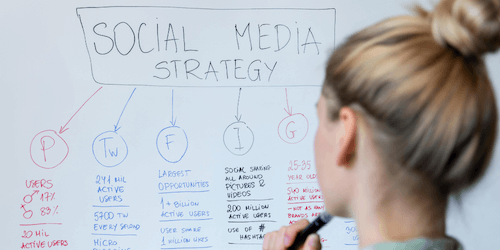
Building a nonprofit social media strategy: 5 steps and tips
Marketing is the backbone of nonprofit growth. It’s required for getting the word out about your various programs and initiatives as well as attracting volunteers and supporters.
However, nonprofit marketing is multi-faceted and requires a number of different platforms and approaches to be successful. One of those key channels is social media.
Social media is more than just a social networking platform. It’s a valuable communication tool that nonprofits use on a daily basis to drive meaningful results for their mission. And that’s what we’ll be focusing on in this guide.
We’ll cover how your nonprofit can develop a social media strategy and provide tips for ensuring it’s a success. Topics we’ll cover include:
- Benefits of building a nonprofit social media strategy.
- 5 steps to craft your nonprofit social media strategy.
- Nonprofit social media content ideas.
- Tips to make the most of social media for your nonprofit.
- Nonprofit social media metrics to measure.
Learning how to get the most out of your social media strategy will help you stay relevant and influential for years to come. Let’s get going!
Benefits of building a nonprofit social media strategy
Research shows that 82% of Americans currently use social media sites. This number has been consistently growing over the last decade, meaning social media is no longer a trend but an essential part of digital marketing.
If you consistently use social media to meet supporters where they are, it will be impactful and rewarding for your organization.
Social media is an effective way to build relationships with minimal resources. It allows supporters to learn more about your organization, engage with your content, and donate — all in the same place.
5 steps to craft your nonprofit social media strategy
1. Define the goals for your social media strategy
Defining the role that social media will play in your larger marketing strategy is essential. Not only will this keep your organization on track, but you can assign each goal or objective a metric to quantify success.
Here are some common goals for a nonprofit social media plan:
- Raise brand awareness.
- Spread important information.
- Increase website traffic.
- Build meaningful relationships.
- Drive donations.
Keep in mind that every social media platform has its own speciality. So, once you determine the goals for your social media strategy, it’s time to start narrowing down your list of preferred platforms.
2. Determine the platforms you’ll use
While having a presence on every social platform allows for maximum reach, it requires a lot of time and resources. Start by consolidating your efforts on one or two platforms.
Doing social media research will help you determine which channels are the right fit for your organization.
Consider how nonprofits use the following social media platforms in their day-to-day operations:

- Facebook: With roughly 3 billion users of all ages, Facebook is an ideal platform for sharing event information and creating fundraising pages. Their live-streaming and story capabilities are also useful for bringing users into the behind-the-scenes of your organization.
- Instagram: Instagram is all about visual media, specifically photos, videos, reels, and stories. Nonprofits can leverage this mobile platform to show the impact of their mission and advocate for support.
- TikTok: If your organization wants to target the younger generation, look no further than TikTok. In addition to creating and posting video content, you can use a feature called “Donation Stickers” that allow viewers to make donations in the app.
- X (formally Twitter): X has strict character limits, making it best for quick updates, discussions with supporters, and interactions with the media. As one of the first social media channels to implement hashtags, it’s a great place to run a hashtag campaign.
- LinkedIn: Nonprofit professionals use LinkedIn to post educational content and position themselves as thought leaders in the industry. Encourage current staff, board members, and volunteers to make their own LinkedIn profiles and interact with other users on your behalf. This will help increase your nonprofit’s brand credibility and exposure.
When searching for the best social media platforms, it all depends on where your nonprofit’s audience is and what type of content you plan to share. Once you’ve got that figured out, you can start planning your content and pushing it live!
3. Create a strategic content calendar
A content calendar is an in-depth look at your upcoming social media posts, including when and where you will post content.
A social media content calendar generally contains the following information:
- The date and time when content will be posted.
- The social media platform and account that will be used.
- Copy and creative assets (photos, videos, links, tags, etc.) needed.
Export this information into a spreadsheet, Google calendar, or social media management tool. No matter how you create your content calendar, it should support the goals you set up for your overall strategy.
4. Develop a social media policy
Another document your nonprofit needs is a social media policy. This outlines how an organization and its members, volunteers, and staff should conduct themselves online.
Think of a social media policy as a code of conduct, covering a wide range of issues like responding to customer service complaints and sharing passwords. It should include the following:
- A directory of people who work on the social platforms.
- Security protocols for using social platforms.
- Crisis communication plans in case of emergencies.
- Guidelines for how staff and volunteers should interact on their personal accounts when talking about your organization.
When it’s time to post on social media, your staff can refer back to this policy to effectively engage in advocacy online. Otherwise, you risk compromising the reputation of your nonprofit with mistakes that could have been avoided with a little planning.
5. Analyze social media metrics to improve your nonprofit’s strategy
Most nonprofits don’t create the perfect social media strategy right off the bat. This isn't a dig at nonprofits. Almost no one ever gets it perfectly right the first time. There’s always room for improvement!
Metrics and measurements are the key to unlocking opportunities to improve your strategy. Use A/B testing to find the perfect way to reach out to your intended audience on social platforms.
Simply put, A/B testing is a type of experiment that uses variables to reveal your supporters’ preferences by showing experiment participants two different versions of something (an A version and a B version).
Here are a few fundamental variables to test:
- Creative: Do donors prefer photos, videos, or plain text?
- Call to Action: Do your supporters click on the “Donate Today” button in your Instagram story? What else might motivate them to click?
- Length: What length of content receives the most engagement, long-form content on Facebook or quick updates on X.
- Focus: Do you notice more conversions when donors are at the center of your posts or when your cause is the focus?
- Platform: What social media platforms do your supporters respond most regularly on?
A social media post can underperform for a variety of reasons, from your call-to-action being unclear to your caption being too long.
But you won’t know until you run tests! You can do this informally, too, by asking staff members or volunteers to take a few minutes to participate.
Nonprofit social media content ideas
Once you build the foundation of your social media strategy, it’s time to plan and push posts live. These content ideas are sure to spark creativity, so you can hit the ground running.

Posts
Posts are usually great for long-form content and encouraging people to read. This is your opportunity to show your impact and spread stories about your organization’s latest programs.
It’s important to post something that encourages people to like, share, or comment. Think of a compelling quote, cute GIF, or a powerful statistic. Don’t be afraid to get creative!
Videos
Videos can be used on TikTok, Facebook, and Instagram to share information about your cause, accomplishments, or events. In general, it’s important to keep videos short to keep your audience’s attention.
After your next annual event, post a video to show the fun time your supporters had to encourage people to attend.
Ads
Advertisements can serve a number of purposes in your strategy, from retargeting your previous visitors to finding new supporters.
To make the most of your nonprofit social media ads, start by using lookalike audiences to find new supporters. Then, once you have your supporters, take advantage of retargeting and email mapping to get in front of current supporters and bring them back to your website.
Images
It may sound cliché, but a picture really is worth a thousand words. Use compelling images to stand out while your supporters are scrolling.
Even better, include pictures of people alongside relevant text for a more relatable post. For instance, if your nonprofit builds houses for low-income families, you can post a photo of a family you helped in front of their new home with a testimonial in the caption.
Stories
Nonprofit storytelling is the best way to communicate impact, which is essential for nonprofits to engage supporters and continually encourage involvement.
Chances are you already have stories of perseverance and hope at your fingertips. Don't let them go to waste.
If you have content that works, adapt it for all your channels. Since Facebook doesn’t have character limits, you can write an in-depth story. Or break the story up into smaller chunks and post them consecutively on X.
Hashtags
Hashtags and hashtag campaigns are a great way to encourage supporters to get involved and participate in posting about your organization. Some of the most effective hashtags serve as their own call to action.
Imagine you’re a humane society hosting an event to raise awareness for rescuing animals. You ask everyone that attends the event to post a picture using the hashtag “#AdoptDon’tShop.” When people see this hashtag in their feed, they will almost immediately understand its purpose. They can click on the hashtag for more information or post their own pet picture using the tag.
Tips to make the most of social media for your nonprofit
Getting attention on social media is exciting, but conversions are more important than impressions.
Follow these tips to transform likes into charitable action:
- Create lookalike audiences to acquire new supporters and followers.
- Retarget segments of your audience with ads on social platforms.
- Add donation buttons directly to your Facebook and Instagram accounts.
- Consider how social media interacts with your other marketing ideas and initiatives.
- Respond to comments when people leave them on your content to interact with them on social platforms.
- Use groups to encourage supporters to interact with one another.
- Find influencers who can help promote your cause and encourage others to get involved.
Investing in a social media strategy may seem overwhelming at first. But, with these tips, the return on investment will be greater than you anticipated.
Nonprofit social media metrics to measure
Hard numbers are the best way to determine how well your nonprofit social media strategy is working. Most social media channels provide their own insights and analytics tools that track who your audience is and how your posts are performing.
Take a closer look at the metrics that best measure your specific goals. Some examples include:
- Campaign click-through rate
- Conversion rate from social media
- Likes, shares, and comments on certain social posts
- Retention over time
- Follower demographics
Watching your follower count increase is great, but engagement is more important. That’s why your organization should be measuring both quantity and quality.
As your numbers grow, are you also seeing a rise in conversions? Are you receiving more comments? Are your videos being watched all the way through?
Take advantage of this information and watch your network grow.
Social media is more than just support for other marketing initiatives — it’s become an important platform to drive supporters to your site and encourage engagement with your organization. Whether you use X or Tiktok, social media will maximize your nonprofit’s reach so that you can continue doing what you do best: powering social good.
You May Also Like
These Related Stories

How to create a nonprofit social media plan that sticks
.png)
Top social media platforms for nonprofits: Where to focus your marketing efforts
